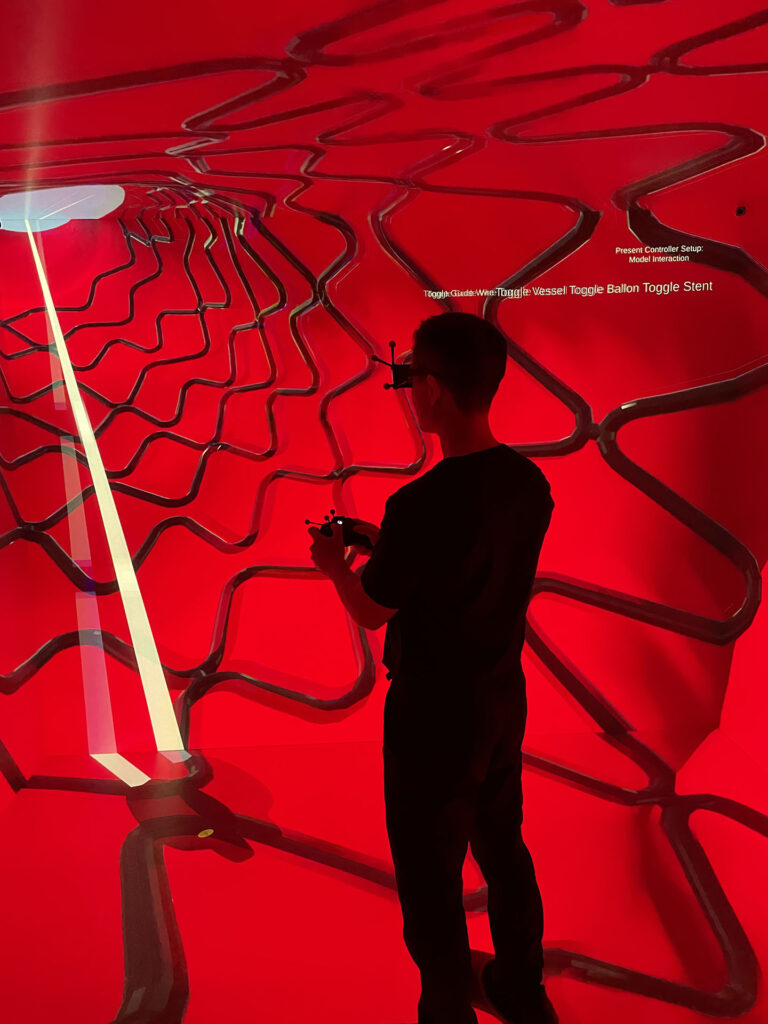Faculty from the UNMC Division of Cardiovascular Medicine, iEXCEL staff and technology from the Davis Global Center are contributing to the development of breakthroughs using Artificial Intelligence (AI), computational Simulations (S) and Extended Reality (ER). The novel use of these technologies in concert creates not just an acronym, but the first demonstration of a new concept, AISER.
AI, computational simulation and ER have each become crucial tools. But together, as AISER, “their symbiosis and synergy might unlock significant potential in patient-specific health care delivery,” according to a new paper, “Artificial Intelligence, Computational Simulations and Extended Reality: Revolutionary Tools in Cardiovascular Interventions,” published Monday in the Journal of American College of Cardiology: Cardiovascular Interventions.
“This report demonstrates what can be achieved when the AI that is supporting advanced 3-D imaging at the Davis Global Center is combined with the knowledge and skill of our Nebraska Medicine Interventional Cardiology clinical team,” said UNMC Chancellor Jeffrey P. Gold, MD, one of the paper’s co-authors.
“The successful design, 3-D modeling and clinical care will define the future of ‘serious medicine and extraordinary care,’ ” Dr. Gold said.

AI and informatics technology are becoming increasingly integrated into health care, and UNMC is among the vanguard. The University of Nebraska established the UNMC Center for Intelligent Health Care (CIHC) in 2020.
John Windle, MD, Holland Distinguished Chair of Cardiovascular Science, the CIHC’s inaugural director and another of the paper’s co-authors, said that establishing AISER “illustrates the potential that can come from optimizing human and computer integration.”
A handful of UNMC faculty are authors on the publication, which includes collaborators from across the country, Europe and Asia. Senior and corresponding author of the paper is Yiannis Chatzizisis, MD, PhD, now at the University of Miami’s Miller School of Medicine. Dr. Chatzizisis developed the technology and completed the project while chief of interventional cardiology at UNMC.
AI can mine and collect patient information, while S, or computational simulation, takes it to the next level through data analysis and prediction of data. And ER’s role? “Disease complexity, interventional procedures and outcomes can be visualized and learned with extended reality (ER),” the authors wrote.
ER is where iEXCEL comes in. “They (Dr. Chatzizisis and cardiovascular faculty) brought us all of their data, but they didn’t have a good way to visualize or experience it,” said Bill Glass, artistic director, iEXCEL visualization. But Glass and the iEXCEL team created next-level models. “We were one of the first to combine different imaging modalities into one and run it as a simulation,” he explained.
Pamela Boyers, PhD, associate vice chancellor of clinical simulation and iEXCEL, is another of the study’s co-investigators from UNMC.
The use of 3-D modeling through ER, and iEXCEL, proved to be the missing piece to AI and computational simulations – and vice versa.
Through AISER, investigators can instantaneously run through 1,000 or more variations to come up with the best candidates for turning population-sized data sets into personalized precision medicine. For example, creating ER models of potential new heart stents in action, then using patient data and computer programming to see which design would work best.
“It is exciting to see the impact of using AI not only to acquire data but to simulate clinical outcomes,” said Daniel Anderson, MD, PhD, another co-investigator. “It is impressive to be able to predict how a stent will deploy in a coronary artery when different segments within the area of deployment area are calcified, fibrosed and/or include a soft, fatty plaque.”
Computational stent simulations by Dr. Chatzizisis, iEXCEL and team, and collaboration with industry helped lead to the invention of a new stent, specifically designed for larger and stiffer heart vessels.
The first of these new stents were successfully implanted in two patients at the Nebraska Medical Center in 2021.
Through AISER, Dr. Anderson said, “We will not only better refine our pre-clinical and clinical research trials, but also enable providers to select appropriate stents and deliver a personalized treatment strategy for atheromatous lesions. Thus, we continue to streamline and elevate our translational clinical research efforts and clinical practice.”

Way to go CV team!! A high honor to be published in this journal, which is a reflection of your hard work.
Congratulations on the publication and demonstration of the AISER technology!
John Windle and Pam Boyer,
Congratulations on all of your hard work to bring the newest technology to iExcel.
Carol Russell